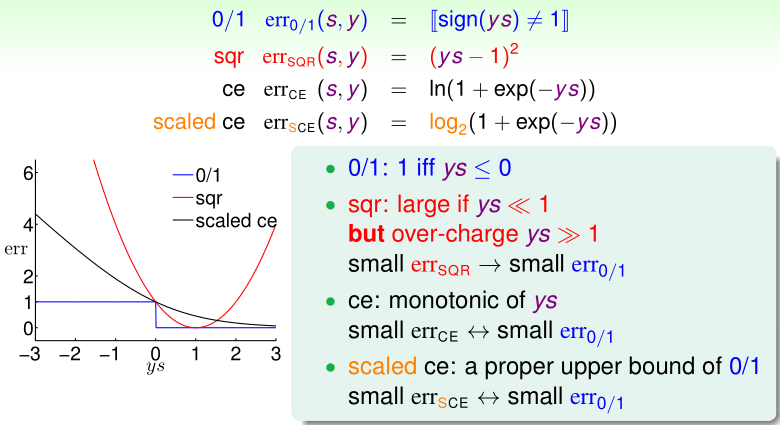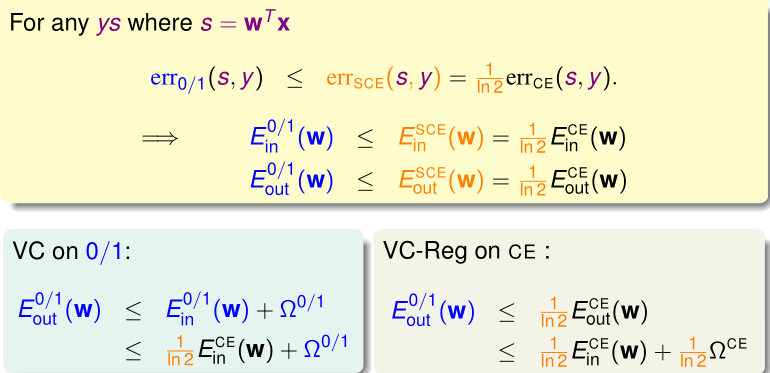Linear Models for Binary Classification
Visualizing Error Functions ($s=w^Tx\ ;\ y\epsilon\{-1,+1\}$)
- linear classification:
$\qquad h(x)=sign(s)\ ;\ err(h,x,y)=[h(x)\neq y]$
$\qquad err_{0/1}(s,y)=[sign(s)\neq y]=[sign(ys)\neq1]$ - linear regresion:
$\qquad h(x)=s\ ;\ err(h,x,y)=(h(x)-y)^2$
$\qquad err_{SQR}(s,y)=(s-y)^2=(ys-1)^2$ - logistic regression:
$\qquad h(x)=\theta(s)\ ;\ err(h,x,y)=-ln\ h(yx)$
$\qquad err_{CE}(s,y)=ln(1+exp(-ys))$
Upper Bound : useful for designing algorithmic error $\hat{err}$
Theoretical Implication of Upper Bound
$small\ E_{in}^{CE}(w)\Rightarrow small\ E_{out}^{0/1}(w)$
logistic / linear reg. for linear classification.
Regression for Classification
run logistic / linear reg. on $D$ with $y_n\epsilon\{-1,+1\}$ to get $w_{REG}$
return $g(x)=sign(w_{REG}^Tx)$
Linear regression sometimes used to set $w_0$ for PLA/pocket/logistic regression
& logistic regression often preferred over pocket.
Stochastic Gradient Descent
PLA 每次迭代只需要选择一个样本,即 $O(1)$ 的时间,而 logistic regression (包括 pocket) 需要检查数据集并通过所有样本来决定 $w_{t+1}$ ,每一次迭代需要 $O(N)$ 的时间.
可以通过随机选取某个样例来更新方向 $v$ ,将这个样例视为多个样例的平均.
pros: simple & cheaper computation —> useful for big data or online learning
cons: less stale in nature
SGD logistic regression $w_{t+1}\leftarrow w_t+\eta \theta(-y_nw_t^Tx_n)(y_nx_n)$
PLA $w_{t+1}\leftarrow w_t+1·[y_n\neq sign(w_t^Tx_n)](y_nx_n)$
- SGD logistic regression $\approx$ ‘soft’ PLA
- PLA $\approx$ SGD logistic regression with $\eta=1$ when $w_t^Tx_n$ large.
two practial rule-of-thumb: stopping condition(t large enough); $\eta$(0.1 when x in proper range)
Multiclass via Logistic Regression
采用OvA策略,即属于 $C_i$ 类别以及不属于 $C_i$ 的类别,这样对于 $N$ 个类别我们有 $N$ 个分类器. 同时为了避免出现分类边界盲区出现,使用 $P(C_i|x)$ 作为基分类器的输出.
$for\ k\epsilon\ Y$
$\qquad obtain\ w_{[k]}\ by\ running\ logistic\ regression\ on$
$\qquad\qquad D_{[k]}=\{(x_n,y_n^{‘}=2[y_n=k]-1)\}_{n=1}^N$
$return \ g(x)=\mathop{argmax}\limits_{k\epsilon Y}(w_{[k]}^Tx)$
pros: efficient, can be coupled with any logistic regression-like approaches
cons: often unbalanced $D_{[k]}$ when $K$ large
extension: multinomial (‘coupled’) logistic regression
Multiclass via Binary Classification
针对OvA中处理 $K$ 较大的情况时效果不太好的情况,提出OvO的策略. 即每一次只考虑两个类别的情况,这样对于 $K$ 个类别,会有 $\binom{K}{2}$ 个分类器.
$for\ (k,l)\ \epsilon\ Y\times Y$
$\qquad\qquad obtain\ w_{[k,l]}\ by\ running\ linear\ binary\ classification\ on$
$\qquad\qquad D_{[k,l]}=\{(x_n,y_n^{‘}=2[y_n=k]-1):y_n=k\ or\ y_n=l\}$
$return\ g(x)=tournament\ champion\ \{w_{[k,l]}^Tx\}$
pros: efficient (‘smaller’ training problems), stable, can be coupled with any binary classification approached
cons: use $O(K^2)\ w_{[k,l]}$ —> more space, slower prediction, more training

